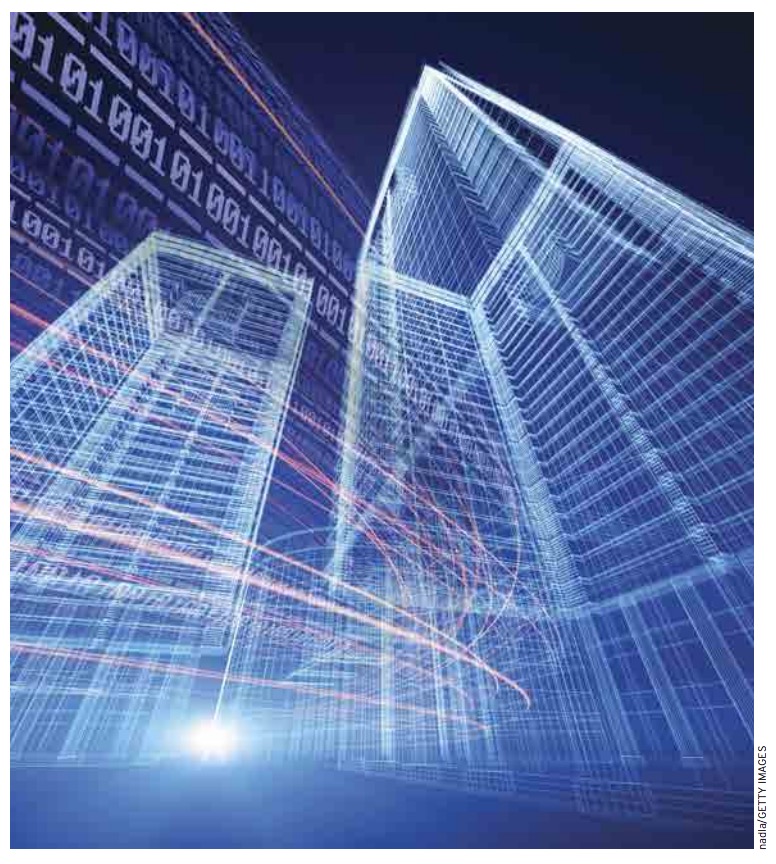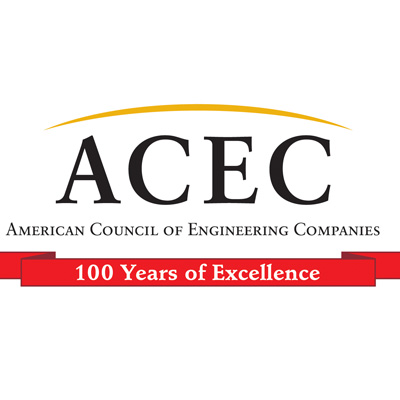AMERICAN COUNCIL OF ENGINEERING COMPANIES (ACEC)
Advances in technology and data management are transforming smart cities from concept to reality, and engineering firms are at the center of the movement
By Samuel Greengard
 It’s no secret: Digital technology now touches almost every aspect of business and life. Yet, as the intersection points grow and data volumes swell, there’s also a growing interest in tapping connected systems to address the challenges of urban living: traffic congestion, energy consumption, air pollution and overall livability. “It’s possible to solve many of today’s problems and deliver significant benefits through the effective use of digital technology,” says Jesse Berst, chairman of the Smart Cities Council.
It’s no secret: Digital technology now touches almost every aspect of business and life. Yet, as the intersection points grow and data volumes swell, there’s also a growing interest in tapping connected systems to address the challenges of urban living: traffic congestion, energy consumption, air pollution and overall livability. “It’s possible to solve many of today’s problems and deliver significant benefits through the effective use of digital technology,” says Jesse Berst, chairman of the Smart Cities Council.
Smart transportation systems make roads safer and less congested. Smart infrastructure improves the delivery of municipal services, such as trash collection and road repair. Smart energy systems reduce consumption and curb air pollution. Finally, smart buildings introduce more comfortable, efficient and sustainable environments.
Already, a growing number of cities around the world—from Barcelona, Spain, to Charlotte, North Carolina— are tapping IT systems, data, sensors and devices to reduce costs, boost efficiency and improve the quality of life. “The smart city concept has evolved beyond a marketing catchphrase. It’s a tangible and viable thing that centers on creating a different and better experience,” says Paul Doherty, president and CEO of the Digit Group, a real estate development and design and construction firm that specializes in smart city development.
Smart cities and smart grids ultimately revolve around building greater infrastructure resiliency, improving the integration of existing and emerging systems, and delivering information that can be used to create revenues and value, says Mike Beehler, vice president at Burns & McDonnell. “It’s all about delivering benefits related to people, profits and planet,” he says.
In fact, as the 21st century unfolds, there’s growing competition among cities to attract new residents, support businesses and entice visitors. At the same time, city officials find themselves contending with increasingly tight budgets, scarce resources and greater citizen expectations.
Getting Smart
According to Frost & Sullivan, a global research and business consulting firm, more than 60 percent of the world’s population will live in urban centers by 2025. In order for these cities to function effectively and deliver vibrant economic conditions along with a high level of livability, it’s nothing less than critical to tap technology— particularly big data and the Internet of Things (IoT)—to fuel innovation and advancements.
“We are witnessing a tremendous convergence of technologies that have the potential to significantly impact the way people live and work,” says Biff Lyons, executive vice president and manager of the Defense and Security Division at Parsons Corp.
For A/E/C firms, the opportunities related to smart cities are enormous. The market is projected to hit $1.5 trillion by 2020, according to Frost & Sullivan. Yet the challenges are also formidable.
There’s a need to understand the diverse and complicated array of digital technologies; design, engineer and build new and more advanced systems using tools such as Building Information Modeling (BIM); integrate new technology with legacy infrastructure; transform raw data into information and insights; and design highly secure IT systems and networks that are resistant to hacks and cyberattacks. Although the smart city concept isn’t new— computers and data already tackle myriad tasks—the next decade and beyond will deliver radical and potentially disruptive changes that will reshape cities and society.
Consider that Barcelona, which was named the world’s top smart city by Jupiter Research in 2015, already has more than 80 smart city initiatives in place, including intelligent street lighting that switches on when there’s motion, trash receptacles that signal when they’re full so that sanitation workers can optimize their routes, sensors that indicate when parking spots are available to motorists, and smart bus stops with LCD screens that display actual arrival times.
The city is also using seawater to cool office buildings. Smarter water systems, street lighting and parking technologies alone have contributed more than $87 billion in savings and 47,000 new jobs, the city reports.
In Charlotte, the quest for a more sustainable and economically viable future has resulted in an intelligent building initiative that relies on a wireless network, smart meters and data analytics software to crunch data and understand how to operate HVAC and other systems more efficiently. The technology, which spans more than 60 buildings that are 10,000 square feet or larger, generates more than 150,000 data points per building each month.
This approach has led directly to a 16.1 percent reduction in energy and more than $17 million in savings. The end goal is a 20 percent reduction in energy consumption.
Although much of the smart city focus is on more efficient transportation grids, improved energy utilization and better use of infrastructure and other finite resources, smart city programs can veer into virtually any area, says Greg Yager, senior vice president and service leader for planning/urban design at CallisonRTKL.
Programs can involve more efficient ways to handle disaster planning and initiatives such as bike share programs and predictive policing. Moreover, these initiatives increasingly involve publicprivate partnerships and other alternative models and methods, including crowdsourcing and machine learning. “The ability to use real-time data to understand behavior, vehicle flows and many other things can prove transformative,” Yager says.
Designs on the Future
Navigating the smart city space requires new thinking and, in some cases, different expertise, says Matt Lamont, national practice leader for architecture and building engineering at Michael Baker International. “When you look at the pace at which smart technologies are evolving, it can all be a bit overwhelming,” he says.
The overarching issue, Lamont adds, is how to generate value. “It’s ultimately not about the technology; it’s about using the technology to build systems and networks that introduce greater efficiencies and cost savings.”
Yager says three central pieces of the concept—people, planet and profit—can be overlooked. “We want a smart city program to optimize city living, the economy and socioeconomic growth of a city and—at the same time—reduce carbon emissions,” he says. “We aim to build net-zero communities.”
Beehler believes it’s critical to start small but think big. This includes participating in pilot projects and working with local officials and developers to create innovative neighborhoods. Burns & McDonnell, which has contributed to a number of smart grid initiatives, including a U.S. Department of Energy-sponsored demonstration project in Kansas City, Missouri, typically focuses on issues such as cost savings, revenue generation, operational efficiencies, sustainability and value. “Smart cities are still in their infancy,” Beehler says. “Are they coming? Absolutely. The challenge for now is demonstrating value and showing how it’s possible to make money—or save money—using these systems,” he adds.
This may translate into an A/E/C firm bolstering skills and knowledge, including data scientists, technologists and visionaries who can understand how devices, APIs, equipment, networks and software translate into better transportation, energy and data systems. In many cases, smart city initiatives also extend to consumer technologies—everything from smart sprinkler systems to smart thermostats—that intersect with utilities and energy grids.
In order to tap the full potential of smart cities, engineers and others must understand how to build networks—and incorporate IoT into systems—without compromising security or data privacy. “There is an ever-increasing need for people who can bridge the gap between the technologists and the business leaders and thus focus on the art of the possible,” Lyons says. “Successful teams must now more than ever be populated with cross-functional expertise and people with the ability to understand and translate data into real world results.”
Yet, achieving success in this brave new world also means harnessing design and engineering tools, such as BIM. Although many firms already use this software to design better buildings, power facilities and other infrastructure, not all use it to maximum potential. “It provides a great deal of insight into how a building or other structure operates over time. It can transform data into an asset management tool,” Lamont says.
What’s more, BIM can help embed the digital DNA into a project that delivers deep and broad insights into the context of a design in relation to a city, district or neighborhood. In addition, Doherty believes that BIM will soon intersect with machine learning and artificial intelligence to speed and improve designs further—and incorporate the resulting structures into more advanced smart city projects.
Although a wide range of companies, including IBM, Cisco, Siemens, Schneider Electric and GE are already heavily represented and invested in the smart cities market, there’s ultimately no turnkey approach or single vendor that can supply all the pieces necessary to drive an initiative forward. In the end, A/E/C firms that embrace smart cities and build a center of expertise are better positioned for the future, Lamont says.
At some point, and it’s not all that far away, engineering firms will require expertise and proficiency in the space, or they won’t be equipped to work on most projects, he adds. “The world is moving forward, and engineering firms must move forward. Smart cities aren’t a futuristic concept—they are taking shape today.”
Download full article (PDF): The Smart Revolution
 About the American Council of Engineering Companies
About the American Council of Engineering Companies
www.acec.org
The American Council of Engineering Companies (ACEC) is the voice of America’s engineering industry. Council members – numbering more than 5,000 firms representing more than 500,000 employees throughout the country – are engaged in a wide range of engineering works that propel the nation’s economy, and enhance and safeguard America’s quality of life. These works allow Americans to drink clean water, enjoy a healthy life, take advantage of new technologies, and travel safely and efficiently. The Council’s mission is to contribute to America’s prosperity and welfare by advancing the business interests of member firms.
Tags: ACEC, American Council of Engineering Companies, Engineering Inc.






 RSS Feed
RSS Feed
I think the vulnerability of smart systems from hacking and cyber attacks is greatly understated and that prevention and recovery techniques should be greatly improved and tested before a lot of these “smart” systems are designed and implemented.